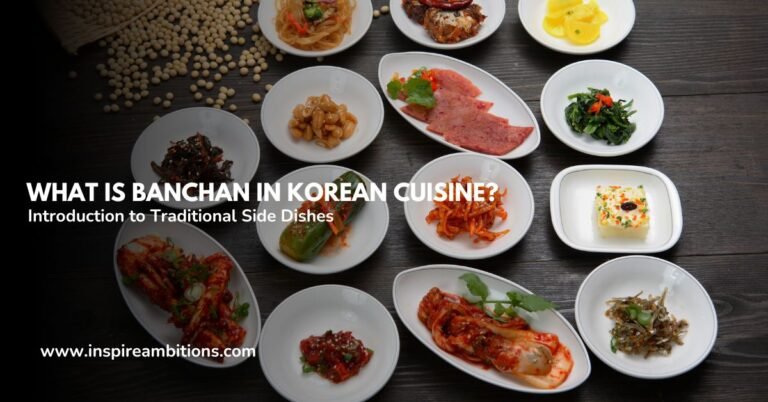कोरियाई भोजन में किस प्रकार के चावल का उपयोग किया जाता है? - मुख्य किस्मों को समझना
When exploring the quintessential flavors of Korean cuisine, one cannot overlook the pivotal role of rice, or “bap,” in Korean. This staple grain is the backbone of numerous dishes and a cultural symbol deeply intertwined with Korea’s history and traditions.

Rice in Korean cuisine primarily refers to short-grain varieties, which are known for their sticky and chewy texture when cooked. This type of rice complements Korean dishes ‘ bold and diverse flavors, perfect for molding into the shape of sushi or enjoying with a spoonful of spicy kimchi.
While white, short-grain rice is most prevalent, other variations include multigrain and purple rice, each contributing unique flavors and nutritional benefits to the Korean diet.
What Type of Rice is Used in Korean Cuisine? – Key Takeaways
- Short-grain white rice is central to Korean cuisine.
- Different types of rice add variety to Korean meals.
- Rice holds significant culinary and cultural importance in Korea.
Types of Korean Rice
Korean cuisine features various types of rice that serve as a staple food and symbol of life and prosperity. Each variety brings its characteristics to the table, suitable for different dishes and preferences.
White Rice
White rice in Korea is typically a short grain rice that’s sticky and slightly sweet when cooked. This variety is essential for making quintessential Korean dishes like bibimbap and kimbap. When preparing white rice, a good rice cooker can make the process easier and produce consistently fluffy rice.
The grains have removed the husk, germ, and bran, yielding a tender bite widely enjoyed in daily meals.
Brown Rice Variants
Brown rice refers to rice that has been less processed than white rice, retaining the bran और germ, thus containing more fiber. Variants such as half-milled brown rice, where some of the bran is removed, and germinating brown rice, with sprouted grains, offer nuttier flavors and more nutrients. They are gaining popularity for their health benefits compared to white rice.
Specialty and Mixed Grains
Beyond the standard white and brown rice, specialty और mixed grains are integral to Korean cuisine. Black rice, शामिल black japonica rice, has a deep purple hue and is prized for its nutrients.
Mixed grain rice, या jargon-bap, typically includes a blend of rice with other grains like barley, millet, and sorghum, providing a rich texture and enhanced taste. These varieties often appear in celebratory meals and implicate a sense of prosperity.
Culinary Applications
In Korean cuisine, the versatility of rice is displayed through a myriad of traditional to contemporary dishes, where its mild taste serves as an ideal canvas for the vibrant flavors of Korean recipes.
Main Dishes and Sides
Rice is the backbone of Korean main dishes and sides. Bibimbap, a mixed rice dish with various vegetables, often includes kimchi and a spicy sauce, highlighting rice’s ability to harmonize diverse flavors. Boribap, a similar dish, incorporates barley to add a chewy texture.
These meals are typically prepared in a steamer, ensuring each grain is perfectly cooked. Rice’s subtle taste lets the intense seasonings of native dishes, like the fermented tang of kimchi, shine through.
- Bibimbap:
- Texture: Chewy, sticky
- Flavours: Varied, includes vegetables and spicy sauce
- Boribap:
- Ingredients: Rice with barley
- Benefit: Adds a chewy texture and nutty flavor
Snacks and Street Food
Rice cakes like tteokbokki are a quintessential Korean street food, famous for their delightfully chewy texture and spicy, sweet sauce. Kimbap uses rice wrapped in seaweed, with fillings ranging from vegetables to fish, showcasing rice’s adaptability.
These snacks are beloved for their portability and are a common sight at सुपरमार्केट and street vendors.
- Tteokbokki:
- Taste: Spicy and sweet
- Popularity: Widely available at street markets
- Kimbap:
- Variety: Includes diverse fillings
- Convenience: Easy to eat on the go
Modern Adaptations
आधुनिक Korean cuisine sees traditional rice dishes evolving, with instant rice products like Hetbahn becoming pantry staples for their convenience. Fried rice dishes, including kimchi fried rice, demonstrate rice’s reinventing ability, infusing old favorites with new life.
These adaptations hold to original flavors while meeting the demands of contemporary life.
- Instant rice (Hetbahn):
- Advantage: Quick and convenient
- Availability: Found in most supermarkets
- Kimchi fried rice:
- Pairing: Combines traditional kimchi with stir-fried rice
- Innovation: Modern take on classic ingredients
Cultural Significance and Nutrition
In Korean cuisine, rice is more than just a staple food. It is a cultural emblem woven into the fabric of daily life, symbolizing prosperity and life itself. A profound understanding of rice’s role in Korean culture includes its cultural symbolism and its nutritional benefits.
Symbolism and Traditions
Rice is entrenched in Korean history as a symbol of life और prosperity. The word for cooked rice, bap (밥), also means “meal,” underscoring its significance. Rice is central to ceremonies and festivities, reflecting long-standing agricultural traditions.
Farming communities take immense pride in cultivating high-quality rice, observing rituals for good harvest, and celebrating its abundance during holidays.
स्वास्थ्य सुविधाएं
Regarding nutrition, Korean rice, particularly germinated brown rice, is rich in proteins, iron, vitamins, and other minerals. This form of rice is noted for its increased nutritional value, including a higher content of beneficial compounds like GABA (gamma-aminobutyric acid).
Korean cuisine often uses various rice types, all valued for their healthful properties, as they contribute to a balanced diet and provide essential nutrients.
Cooking Techniques and Tips
In Korean cuisine, the rice used is not merely a side dish; it’s integral to the meal’s flavor and presentation. Handling this staple grain is crucial for achieving the desired texture and taste.
तैयारी के तरीके
Before you start cooking, it’s essential to select the right quality of rice that has undergone an adequate milling process, ensuring that the grains are neither too polished nor too coarse, as this affects the retention of B vitamins.
Most Koreans prefer using a high-quality rice cooker to ensure consistency in cooking, but other traditional methods like steaming are also prominent.
- Rinse: Always rinse the rice in cold water until the water runs clear to remove excess starch, which can otherwise make the rice overly sticky.
- Soak: For most Korean short-grain rice, soaking for 30 minutes can be a cardinal step. This allows the rice to absorb moisture evenly, contributing to the rice’s chewy texture after cooking.
Achieving Perfect Texture
The texture of the rice is paramount in Korean cuisine. You’re aiming for rice that is sticky enough to hold together but retains a certain chewiness.
- Water Ratio: Include the right amount of water – generally, the ratio of water to rice can range from 1:1 to 1.5:1, depending on whether the rice was soaked.
- Cooking Time: Cooking time can vary; use a rice cooker or a steamer to automate this process if you prefer a more hands-on approach.
Remember to let the rice stand after cooking to allow the remaining moisture to redistribute, creating a more uniform texture. High-starch Korean rice can potentially have a high glycemic index, so it’s crucial for those watching their blood sugar to be mindful of portion sizes.





